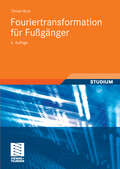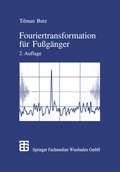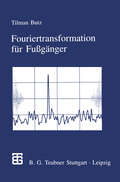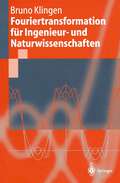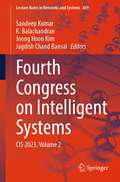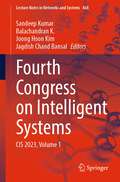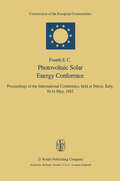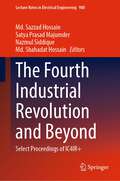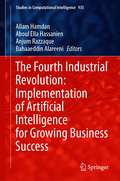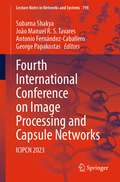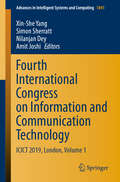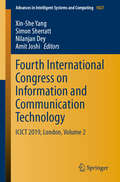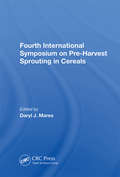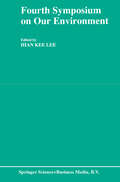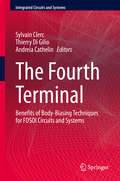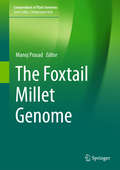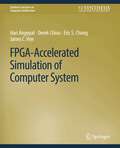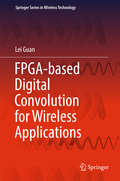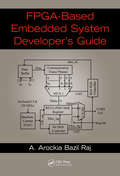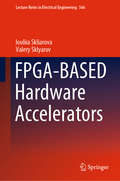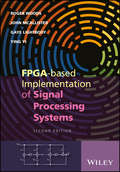- Table View
- List View
Fouriertransformation für Fußgänger
by Tilman ButzDieses unterhaltsame Lehrbuch wendet sich an alle, die in der Ausbildung und in ihrer beruflichen Praxis mit Fouriertransformationen zu tun haben. Das Buch behandelt sowohl Fourierreihen als auch kontinuierliche und diskrete Fouriertransformationen. Außerdem werden Fensterfunktionen ausführlich diskutiert. Zahlreiche Abbildungen und Beispiele, die vom Leser meist von Hand nachgerechnet werden können, machen den Stoff leicht verständlich.
Fouriertransformation für Fußgänger
by Tilman ButzDieses Werk ist ein unterhaltsames Lehrbuch. Es wendet sich an alle, die in der Ausbildung und in ihrer beruflichen Praxis mit Fouriertransformationen zu tun haben: Studenten der Ingenieur- und Naturwissenschaften, aber auch Praktiker, die Spektralanalysen oder Fouriertransformationsmethoden benötigen. Dabei sind elementare Kenntnisse der Integralrechnung wünschenswert. Das Buch behandelt sowohl Fourierreihen als auch kontinuierliche und diskrete Fouriertransformationen. Zahlreiche Abbildungen und Beispiele, die vom Leser meist von Hand nachgerechnet werden können, machen den Stoff leicht verdaulich.
Fouriertransformation für Ingenieur- und Naturwissenschaften (Springer-Lehrbuch)
by Bruno KlingenDieses Lehrbuch wendet sich an Studenten der Ingenieurfächer und der Naturwissenschaften. Durch seinen systematischen und didaktischen Aufbau vermeidet es ungenaue Formulierungen und legt so die Grundlage für das Verständnis auch neuerer Methoden. Indem die klassische und die Funktionalanalysis auf der Basis des Fourieroperators zusammengeführt werden, vermittelt es ein fundiertes und verantwortbares Umgehen mit der Fouriertransformation. Gleichzeitig bietet dieses Konzept die Möglichkeit, auch die Fourierreihen, die diskrete Fouriertransformation und die Behandlung der diskreten Filter in einem einheitlichen Zusammenhang darzustellen. Das Buch enthält zahlreiche gelöste Übungsaufgaben. NEU ! Online-Ergänzungen zum Buch im Internet: - zum Kennenlernen und Vergleichen der mathematischen Programmiersysteme Mathematica, Matlab, Maple - zur Vertiefung des Buchinhaltes (unter "Extras im Web")
Fourth Congress on Intelligent Systems: CIS 2023, Volume 2 (Lecture Notes in Networks and Systems #869)
by Sandeep Kumar K. Balachandran Joong Hoon Kim Jagdish Chand BansalThis book is a collection of selected papers presented at the Fourth Congress on Intelligent Systems (CIS 2023), organized by CHRIST (Deemed to be University), Bangalore, India, under the technical sponsorship of the Soft Computing Research Society, India, during September 4–5, 2023. It includes novel and innovative work from experts, practitioners, scientists, and decision-makers from academia and industry. It covers topics such as the Internet of Things, information security, embedded systems, real-time systems, cloud computing, big data analysis, quantum computing, automation systems, bio-inspired intelligence, cognitive systems, cyber-physical systems, data analytics, data/web mining, data science, intelligence for security, intelligent decision-making systems, intelligent information processing, intelligent transportation, artificial intelligence for machine vision, imaging sensors technology, image segmentation, convolutional neural network, image/video classification, soft computing for machine vision, pattern recognition, human-computer interaction, robotic devices and systems, autonomous vehicles, intelligent control systems, human motor control, game playing, evolutionary algorithms, swarm optimization, neural network, deep learning, supervised learning, unsupervised learning, fuzzy logic, rough sets, computational optimization, and neuro-fuzzy systems.
Fourth Congress on Intelligent Systems: CIS 2023, Volume 1 (Lecture Notes in Networks and Systems #868)
by Sandeep Kumar Balachandran K. Joong Hoon Kim Jagdish Chand BansalThis book is a collection of selected papers presented at the Fourth Congress on Intelligent Systems (CIS 2023), organized by CHRIST (Deemed to be University), Bangalore, India, under the technical sponsorship of the Soft Computing Research Society, India, during September 4–5, 2023. It includes novel and innovative work from experts, practitioners, scientists, and decision-makers from academia and industry. It covers topics such as the Internet of Things, information security, embedded systems, real-time systems, cloud computing, big data analysis, quantum computing, automation systems, bio-inspired intelligence, cognitive systems, cyber-physical systems, data analytics, data/web mining, data science, intelligence for security, intelligent decision-making systems, intelligent information processing, intelligent transportation, artificial intelligence for machine vision, imaging sensors technology, image segmentation, convolutional neural network, image/video classification, soft computing for machine vision, pattern recognition, human-computer interaction, robotic devices and systems, autonomous vehicles, intelligent control systems, human motor control, game playing, evolutionary algorithms, swarm optimization, neural network, deep learning, supervised learning, unsupervised learning, fuzzy logic, rough sets, computational optimization, and neuro-fuzzy systems.
Fourth E.C. Photovoltaic Solar Energy Conference: Proceedings of the International Conference, held at Stresa, Italy, 10–14 May, 1982
by W. H. Bloss G. GrassiThis paper is written in the belief that people are important and that equipment is to serve the needs of the people and therefore should be designed to meet their specific needs and environment. This is particularly important in the case of a developing country when a professional engineer accepts the responsibility to formulate policies evaluate equipment imple ment projects and train national people. 1. Government, geography and climate Papua New Guinea, an independent and self governing state since 1975, is located directly North of Australia above the North Eastern State of Queensland. The country extends from 141° east longitude, at the border with Indonesia (Irian Jaya) to 160° east longitude and between latitudes 1° and 12° south (see figure 1). Papua New Guinea is a parliamentary democracy, with a single legis lature known as the National Parliament (1). The State is divided into 19 provinces plus the National Capital District (Port Moresby) with de centralized Government established in each province. Before independence the country comprised the Australian territory of Papua in the southern regions and the United Nations Trust Territory of New Guinea in the North (1). Land area is 462,840 square kilometres This inclUdes the mainland, the three large islands of New Britain, ~ew Ireland and fiougainville plus 600 small islands and archipelagos. Approximate direct distances from the capital city of Port Moresby to some of the other centres are : Vanimo 990 km, Rabaul SOO km, Arawa 990 km and Lorengau S25 km.
The Fourth Industrial Revolution and Beyond: Select Proceedings of IC4IR+ (Lecture Notes in Electrical Engineering #980)
by Md. Sazzad Hossain Satya Prasad Majumder Nazmul Siddique Md. Shahadat HossainThe book constitutes selected peer-reviewed proceedings of the International Conference on the 4th Industrial Revolution and Beyond (IC4IR 2021). It focuses on the research trends, challenges, and future of artificial intelligence (AI). It explores the potential for the integration of advanced AI algorithms. The book addresses the challenges of Data Science for industrial applications in developing and under-developed countries and various security issues. It includes qualitative and quantitative research and provides case studies with working models. The book focuses on artificial intelligence and its applications for industry, innovation, and infrastructure. The book serves as a reference book for practitioners and researchers working in the areas of AI, soft computing, IoT, and data analytics.
The Fourth Industrial Revolution: Implementation of Artificial Intelligence for Growing Business Success (Studies in Computational Intelligence #935)
by Allam Hamdan Aboul Ella Hassanien Anjum Razzaque Bahaaeddin AlareeniThis book focuses on the implementation of AI for growing business, and the book includes research articles and expository papers on the applications of AI on decision-making, health care, smart universities, public sector and digital government, FinTech, and RegTech. Artificial Intelligence (AI) is a vital and a fundamental driver for the Fourth Industrial Revolution (FIR). Its influence is observed at homes, in the businesses and in the public spaces. The embodied best of AI reflects robots which drive our cars, stock our warehouses, monitor our behaviors and warn us of our health, and care for our young children. Some researchers also discussed the role of AI in the current COVID-19 pandemic, whether in the health sector, education, and others. On all of these, the researchers discussed the impact of AI on decision-making in those vital sectors of the economy.
Fourth International Conference on Image Processing and Capsule Networks: ICIPCN 2023 (Lecture Notes in Networks and Systems #798)
by Subarna Shakya João Manuel R. S. Tavares Antonio Fernández-Caballero George PapakostasThis book includes high-quality research papers presented at the Fourth International Conference on Image Processing and Capsule Networks (ICIPCN 2023), which is held in Bangkok, Thailand, during 10–11 August 2023. This book provides a collection of the state-of-the-art research attempts to tackle the challenges in image and signal processing from various novel and potential research perspectives. The book investigates feature extraction techniques, image enhancement methods, reconstruction models, object detection methods, recommendation models, deep and temporal feature analysis, intelligent decision support systems, and autonomous image detection models. In addition to this, the book also looks into the potential opportunities to monitor and control the global pandemic situations.
Fourth International Congress on Information and Communication Technology: ICICT 2019, London, Volume 1 (Advances in Intelligent Systems and Computing #1041)
by Xin-She Yang Nilanjan Dey Amit Joshi Simon SherrattThis book gathers selected high-quality research papers presented at the Fourth International Congress on Information and Communication Technology, held at Brunel University, London, on February 27–28, 2019. It discusses emerging topics pertaining to information and communication technology (ICT) for managerial applications, e-governance, e-agriculture, e-education and computing technologies, the Internet of things (IoT), and e-mining. Written by respected experts and researchers working on ICT, the book offers a valuable asset for young researchers involved in advanced studies.
Fourth International Congress on Information and Communication Technology: ICICT 2019, London, Volume 2 (Advances in Intelligent Systems and Computing #1027)
by Xin-She Yang Simon Sherratt Nilanjan Dey Amit JoshiThe second volume of this book includes selected high-quality research papers presented at the Fourth International Congress on Information and Communication Technology, which was held at Brunel University, London, on February 27–28, 2019. It discusses emerging topics pertaining to information and communication technology (ICT) for managerial applications, e-governance, e-agriculture, e-education and computing technologies, the Internet of Things (IoT), and e-mining. Written by respected experts and researchers actively working in ICT, the book offers a valuable resource, especially for researchers who are newcomers to the field.
Fourth International Symposium On Pre-harvest Sprouting In Cereals
by Daryl MaresA major constraint on the production of high-quality grain around the world, pre-harvest sprouting in cereal crops causes substantial economic losses to producers and disrupts the processing, distribution, marketing, and storage of grain products. The solution to this problem must include a better understanding of the phenomenon, the development of
Fourth International Symposium On Pre-harvest Sprouting In Cereals
by Daryl MaresA major constraint on the production of high-quality grain around the world, pre-harvest sprouting in cereal crops causes substantial economic losses to producers and disrupts the processing, distribution, marketing, and storage of grain products. The solution to this problem must include a better understanding of the phenomenon, the development of
Fourth RILEM International Conference on Concrete and Digital Fabrication: Digital Concrete 2024 (RILEM Bookseries #53)
by Dirk Lowke Niklas Freund David Böhler Friedrich HerdingThis book gathers peer-reviewed contributions presented at the 4th RILEM International Conference on Concrete and Digital Fabrication (Digital Concrete), held in Munich, Germany, on September 4-6, 2024. Focusing on additive and automated manufacturing technologies for the fabrication of cementitious construction materials, such as 3D concrete printing, powder bed printing, and shotcrete 3D printing, the papers highlight the latest findings in this fast-growing field, addressing topics like mixture design, admixtures, rheology and fresh-state behavior, alternative materials, microstructure, cold joints & interfaces, mechanical performance, reinforcement, structural engineering, durability and sustainability, automation and industrialization.
Fourth Symposium on our Environment: Proceedings of the Fourth Symposium on Our Environment, held in Singapore, May 21–23, 1990
by Hian Kee Hian Kee LeeProceedings of the Fourth Symposium on Our Environment, held in Singapore, May 21-23, 1990
The Fourth Terminal: Benefits of Body-Biasing Techniques for FDSOI Circuits and Systems (Integrated Circuits and Systems)
by Sylvain Clerc Thierry Di Gilio Andreia CathelinThis book discusses the advantages and challenges of Body-Biasing for integrated circuits and systems, together with the deployment of the design infrastructure needed to generate this Body-Bias voltage. These new design solutions enable state of the art energy efficiency and system flexibility for the latest applications, such as Internet of Things and 5G communications.
Fowler-Nordheim Field Emission: Effects in Semiconductor Nanostructures (Springer Series in Solid-State Sciences #170)
by Kamakhya Prasad Ghatak Sitangshu BhattacharyaThis monograph solely presents the Fowler-Nordheim field emission (FNFE) from semiconductors and their nanostructures. The materials considered are quantum confined non-linear optical, III-V, II-VI, Ge, Te, carbon nanotubes, PtSb2, stressed materials, Bismuth, GaP, Gallium Antimonide, II-V, Bi2Te3, III-V, II-VI, IV-VI and HgTe/CdTe superlattices with graded interfaces and effective mass superlattices under magnetic quantization and quantum wires of the aforementioned superlattices. The FNFE in opto-electronic materials and their quantum confined counterparts is studied in the presence of light waves and intense electric fields on the basis of newly formulated electron dispersion laws that control the studies of such quantum effect devices. The importance of band gap measurements in opto-electronic materials in the presence of external fields is discussed from this perspective. This monograph contains 200 open research problems which form the very core and are useful for Ph. D students and researchers. The book can also serve as a basis for a graduate course on field emission from solids.
The Foxtail Millet Genome (Compendium of Plant Genomes)
by Manoj PrasadThis book presents up-to-date information on foxtail millet genomics, with a particular focus on its agronomic importance, genome architecture, marker development, evolutionary and diversity studies, comparative genomics and stress biology. The topics discussed have the potential to open up a new era of crop improvement in foxtail millet and other related grass species.Foxtail millet (Setaria italica L.) is the oldest domesticated crop in the world (domesticated >8700 years ago) and it has been extensively grown in the semi-arid regions of Asia, Europe and the Americas as a food and fodder crop ever since. Further, as a C4 crop with close genetic relatedness to several biofuel grasses, foxtail millet has been promoted as a model plant. In view of its importance, the US Department of Energy Joint Genome Institute and Beijing Genomics Institute have independently sequenced the genome of foxtail millet. The availability of the draft genome sequence has advanced the genomics and genetics of this important crop, resulting in the development of large-scale genome-wide molecular markers and demonstration of their utility in genomics-assisted breeding, as well as the identification of the molecular and biological roles of several stress-responsive gene families in connection with abiotic stress tolerance. In addition, several open access databases have been developed to make these resources for crop improvement through structural and functional genomics widely available.
FPGA-Accelerated Simulation of Computer Systems (Synthesis Lectures on Computer Architecture)
by Hari Angepat Derek Chiou Eric S. Chung James C. HoeTo date, the most common form of simulators of computer systems are software-based running on standard computers. One promising approach to improve simulation performance is to apply hardware, specifically reconfigurable hardware in the form of field programmable gate arrays (FPGAs). This manuscript describes various approaches of using FPGAs to accelerate software-implemented simulation of computer systems and selected simulators that incorporate those techniques. More precisely, we describe a simulation architecture taxonomy that incorporates a simulation architecture specifically designed for FPGA accelerated simulation, survey the state-of-the-art in FPGA-accelerated simulation, and describe in detail selected instances of the described techniques. Table of Contents: Preface / Acknowledgments / Introduction / Simulator Background / Accelerating Computer System Simulators with FPGAs / Simulation Virtualization / Categorizing FPGA-based Simulators / Conclusion / Bibliography / Authors' Biographies
FPGA-based Digital Convolution for Wireless Applications (Springer Series in Wireless Technology)
by Lei GuanThis book presents essential perspectives on digital convolutions in wireless communications systems and illustrates their corresponding efficient real-time field-programmable gate array (FPGA) implementations. FPGAs or generic all programmable devices will soon become widespread, serving as the “brains” of all types of real-time smart signal processing systems, like smart networks, smart homes and smart cities. The book examines digital convolution by bringing together the following main elements: the fundamental theory behind the mathematical formulae together with corresponding physical phenomena; virtualized algorithm simulation together with benchmark real-time FPGA implementations; and detailed, state-of-the-art case studies on wireless applications, including popular linear convolution in digital front ends (DFEs); nonlinear convolution in digital pre-distortion (DPD) enabled high-efficiency wireless RF transceivers; and fast linear convolution in massive multiple-input multiple-output (MIMO) systems.After reading this book, students and professionals will be able to:· Understand digital convolution with inside-out information: discover what convolution is, why it is important and how it works.· Enhance their FPGA design skills, i.e., enhance their FPGA-related prototyping capability with model-based hands-on examples.· Rapidly expand their digital signal processing (DSP) blocks: to examine how to rapidly and efficiently create (DSP) functional blocks on a programmable FPGA chip as a reusable intellectual property (IP) core.· Upgrade their expertise as both “thinkers” and “doers”: minimize/close the gap between mathematical equations and FPGA implementations for existing and emerging wireless applications.
FPGA-Based Embedded System Developer's Guide
by A. Arockia RajThe book covers various aspects of VHDL programming and FPGA interfacing with examples and sample codes giving an overview of VLSI technology, digital circuits design with VHDL, programming, components, functions and procedures, and arithmetic designs followed by coverage of the core of external I/O programming, algorithmic state machine based system design, and real-world interfacing examples. • Focus on real-world applications and peripherals interfacing for different applications like data acquisition, control, communication, display, computing, instrumentation, digital signal processing and top module design • Aims to be a quick reference guide to design digital architecture in the FPGA and develop system with RTC, data transmission protocols
FPGA-Based Embedded System Developer's Guide
by A. Arockia RajThe book covers various aspects of VHDL programming and FPGA interfacing with examples and sample codes giving an overview of VLSI technology, digital circuits design with VHDL, programming, components, functions and procedures, and arithmetic designs followed by coverage of the core of external I/O programming, algorithmic state machine based system design, and real-world interfacing examples. • Focus on real-world applications and peripherals interfacing for different applications like data acquisition, control, communication, display, computing, instrumentation, digital signal processing and top module design • Aims to be a quick reference guide to design digital architecture in the FPGA and develop system with RTC, data transmission protocols
FPGA-BASED Hardware Accelerators (Lecture Notes in Electrical Engineering #566)
by Valery Sklyarov Iouliia SkliarovaThis book suggests and describes a number of fast parallel circuits for data/vector processing using FPGA-based hardware accelerators. Three primary areas are covered: searching, sorting, and counting in combinational and iterative networks. These include the application of traditional structures that rely on comparators/swappers as well as alternative networks with a variety of core elements such as adders, logical gates, and look-up tables. The iterative technique discussed in the book enables the sequential reuse of relatively large combinational blocks that execute many parallel operations with small propagation delays. For each type of network discussed, the main focus is on the step-by-step development of the architectures proposed from initial concepts to synthesizable hardware description language specifications. Each type of network is taken through several stages, including modeling the desired functionality in software, the retrieval and automatic conversion of key functions, leading to specifications for optimized hardware modules. The resulting specifications are then synthesized, implemented, and tested in FPGAs using commercial design environments and prototyping boards. The methods proposed can be used in a range of data processing applications, including traditional sorting, the extraction of maximum and minimum subsets from large data sets, communication-time data processing, finding frequently occurring items in a set, and Hamming weight/distance counters/comparators. The book is intended to be a valuable support material for university and industrial engineering courses that involve FPGA-based circuit and system design.
FPGA-based Implementation of Signal Processing Systems
by Roger Woods John McAllister Gaye Lightbody Ying YiAn important working resource for engineers and researchers involved in the design, development, and implementation of signal processing systems The last decade has seen a rapid expansion of the use of field programmable gate arrays (FPGAs) for a wide range of applications beyond traditional digital signal processing (DSP) systems. Written by a team of experts working at the leading edge of FPGA research and development, this second edition of FPGA-based Implementation of Signal Processing Systems has been extensively updated and revised to reflect the latest iterations of FPGA theory, applications, and technology. Written from a system-level perspective, it features expert discussions of contemporary methods and tools used in the design, optimization and implementation of DSP systems using programmable FPGA hardware. And it provides a wealth of practical insights—along with illustrative case studies and timely real-world examples—of critical concern to engineers working in the design and development of DSP systems for radio, telecommunications, audio-visual, and security applications, as well as bioinformatics, Big Data applications, and more. Inside you will find up-to-date coverage of: FPGA solutions for Big Data Applications, especially as they apply to huge data sets The use of ARM processors in FPGAs and the transfer of FPGAs towards heterogeneous computing platforms The evolution of High Level Synthesis tools—including new sections on Xilinx's HLS Vivado tool flow and Altera's OpenCL approach Developments in Graphical Processing Units (GPUs), which are rapidly replacing more traditional DSP systems FPGA-based Implementation of Signal Processing Systems, 2nd Edition is an indispensable guide for engineers and researchers involved in the design and development of both traditional and cutting-edge data and signal processing systems. Senior-level electrical and computer engineering graduates studying signal processing or digital signal processing also will find this volume of great interest.
